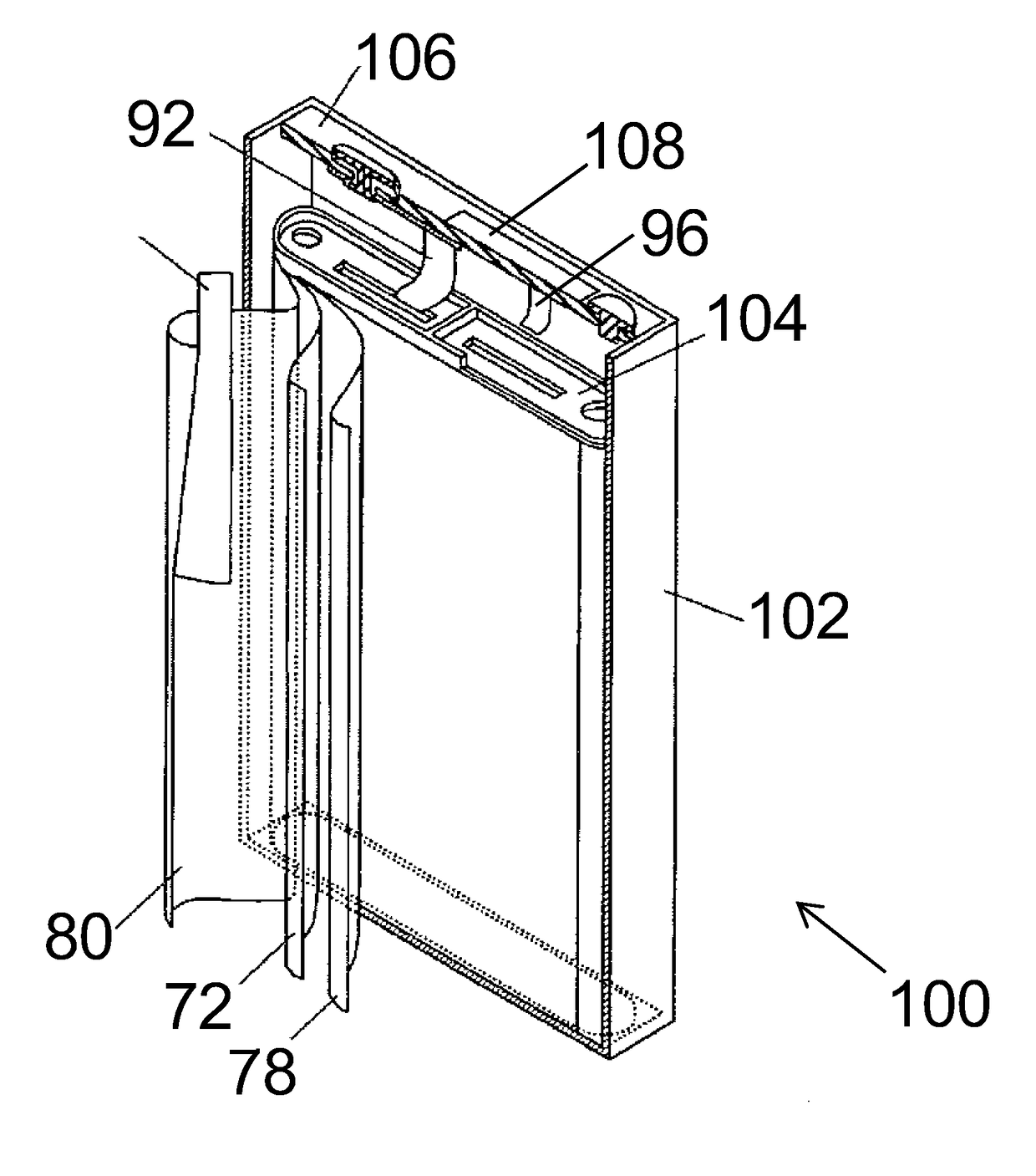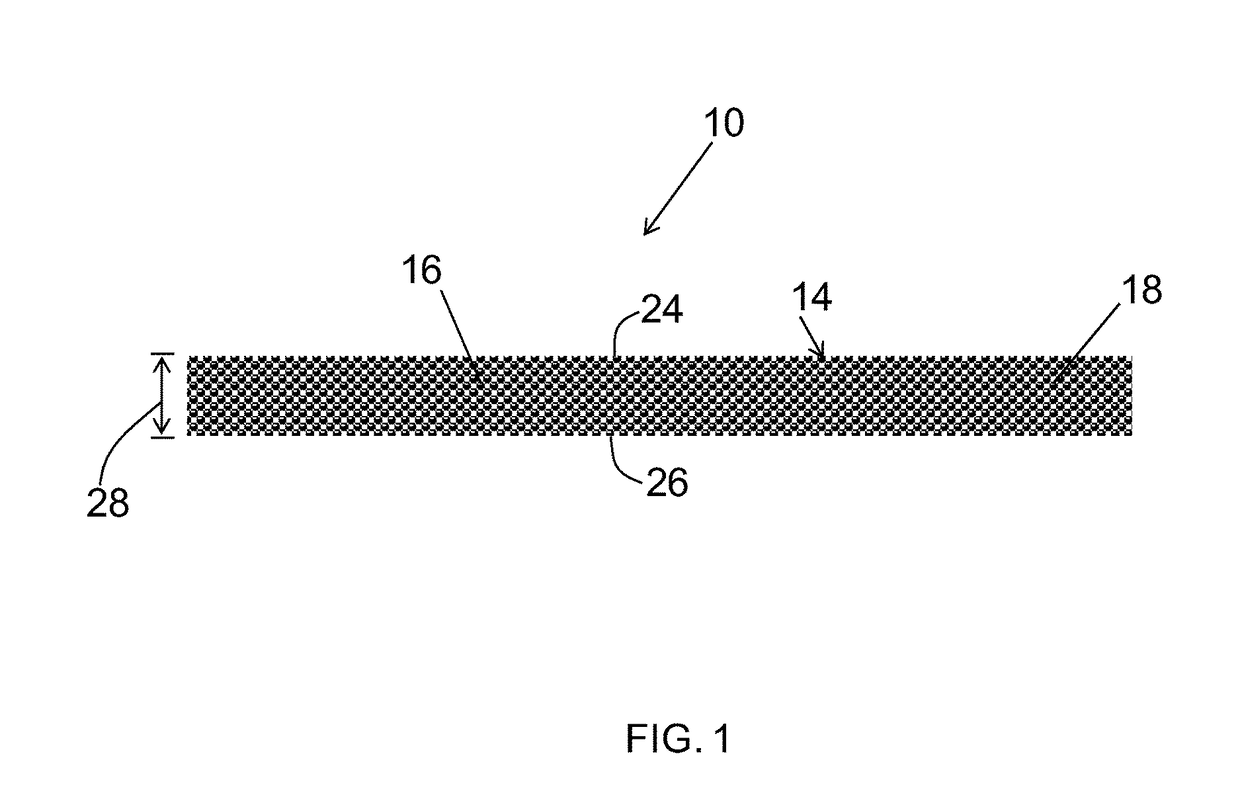Freestanding, heat resistant microporous film for use in energy storage devices
a technology of energy storage devices and microporous films, which is applied in secondary cell servicing/maintenance, battery components, cell components, etc., can solve the problems of difficult processing into fibers, sheets, or membranes, and achieve low thermal shrinkage, high loading levels, and maintain porosity
- Summary
- Abstract
- Description
- Claims
- Application Information
AI Technical Summary
Benefits of technology
Problems solved by technology
Method used
Image
Examples
example 1
[0059]Process oil-filled sheets were produced from seven formulations (identified by letters A-G) listed in Table 1. For each formulation, ingredients were combined in a horizontal mixer by adding all dry ingredients to the mixer and blending them with low speed agitation to form a homogeneous mix. Hot process oil was sprayed onto the blended dry ingredients, and the mixture was then fed to a 96 mm counter-rotating twin screw extruder (ENTEK Manufacturing, Inc.) operating at a melt temperature of about 215° C. Additional process oil was added in-line at the throat of the extruder to give a final process oil content of approximately 65 wt %-68 wt %. The resultant melt was passed through a sheet die into a calender, in which the gap was used to control the extrudate thickness in the range of 150 μm-200 μm.
[0060]
TABLE 1FormulationRaw MaterialSupplierUnitsABCDEFGSilica, 1165 MP milledRhodiakg200200200200Silica, WB-37PPGkg200200200UHMWPE, GUR 4150Ticonakg180.5141.4115.38796.78775.2Colora...
example 2
[0062]Process oil-filled sheets produced from the seven formulations listed in Table 1 were sequentially stretched in the machine direction (MD) and transverse direction (TD) using Machine Direction Orientation and Tenter Frame equipment available at Parkinson Technologies Inc., Woonsocket, R.I. The process oil-filled sheets were stretched at elevated temperature (115° C.-121° C.) to form a process oil-filled film of about 10 μm-40 μm thickness. Rolls of the thinner, process oil-filled sheet were then extracted in a portable extractor-dryer unit, where trichloroethylene was used to remove the process oil and hot air was used to drive off the solvent to form a freestanding, dimensionally stable microporous film.
[0063]The microporous films were tested for thickness, air permeability (Gurley Model No. 4340), and puncture strength.
[0064]The Gurley Model No. 4340 Automatic Densometer measures air permeability in terms of seconds at standard pressure. Specifically, the Gurley value is tim...
example 3
[0072]The films of formulations D and E were first annealed (i.e., heat treated) at elevated temperature and then subsequently tested for MD and TD shrinkage at 200° C. This approach is used to relax residual stress from the biaxial orientation and process oil and solvent extraction processes to further improve dimensional stability, as shown in Table 3. Annealing can be done through either an on-line or an off-line process.
[0073]
TABLE 3Shrinkage afterStretchThick-Puncture1 hr @ 200° C.rationessGurleystrengthMDTDFormulationMDTD(μm)(secs)(g)%%DAs Produced343610120813.48.3Annealed at34341641946.93.0165° C.EAs Produced2.54241142007.66.8Annealed at2.5423411533.11.3185° C.
[0074]Examples 4 and 5 below represent heat treated, fumed aluminum oxide-filled microporous films that include polymer matrices containing, respectively, UHMWPE alone and UHMWPE blended with XLPE.
PUM
| Property | Measurement | Unit |
|---|---|---|
| volume fraction | aaaaa | aaaaa |
| melting point | aaaaa | aaaaa |
| melting point | aaaaa | aaaaa |
Abstract
Description
Claims
Application Information
 Login to View More
Login to View More - R&D
- Intellectual Property
- Life Sciences
- Materials
- Tech Scout
- Unparalleled Data Quality
- Higher Quality Content
- 60% Fewer Hallucinations
Browse by: Latest US Patents, China's latest patents, Technical Efficacy Thesaurus, Application Domain, Technology Topic, Popular Technical Reports.
© 2025 PatSnap. All rights reserved.Legal|Privacy policy|Modern Slavery Act Transparency Statement|Sitemap|About US| Contact US: help@patsnap.com



